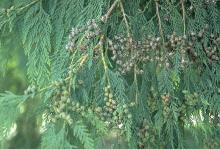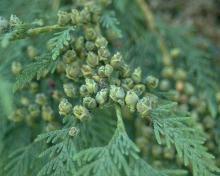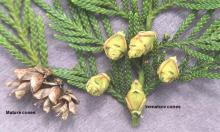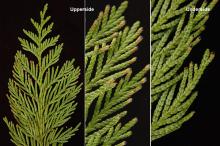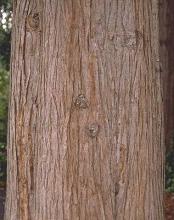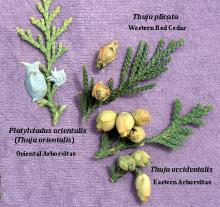Thuja plicata
Common name:
Western Red Cedar
Giant Western Arborvitae
Pronunciation:
THEW-ya pli-KHA-ta
Family:
Cupressaceae
Genus:
Type:
Conifer
Native to (or naturalized in) Oregon:
Yes
- Conifer, evergreen tree, 50-70(200) ft, [15-21(61) m], narrow, pyramidal, buttressed base. Usually maintains lower branches. Branches horizontal or drooping but turning upward at the end, especially the lower branches. Leaves, scale-like, opposite, in 4 rows, 1.5-3 mm long, shiny dark green, usually with white markings ("butterfly" pattern) on the underside. Cones elliptical, only 12 mm long, clustered and upright, sharp-pointed cone scales.
- Sun to partial shade. Prefers moist, well-drained, fertile soils, pH adaptable. In the wild found in moist flats, slopes, and banks of rivers. Can be maintained in a hedge.
- Hardy to USDA Zone 5 Native range extends from Alaska south to Washngton, Oregon and into to northern California, and east to Montana. It is one of the four native "cedars" (so-called) in Oregon. For a comparison of the four native "cedars" see Four "cedar" species native to Oregon
- Thuja plicata is the Provincial Tree of British Columbia
- Western Red Cedar has been called the "corner stone of northwest coast Indian culture". Its wood is easily split and rot resistant and was used to make important cultural items including, dugout canoes, paddles, house planks, baskets, spears, arrow shafts, and many other implements. The bark was stripped from trees in the spring, hung up to dry, and then beaten until it separated into layers ready for making baskets, ropes, and mates. Red Cedar was considered an excellent fuel, especially for drying fish, because it burns with little smoke (Pojar and MacKinnon, 1994).
-
Some of the available cultivars of Thuja plicata include:
- ‘Atrovirens’ - typical habit, foliage green throughout the year; originated in Worcester, England about 1874
- 'Can Can' - semi-dwarf tree, dense, upright habit, dark green foliage with golden-white tips
- ‘Excelsa’ - narrow habit, branches strongly ascending, dense, foliage dark green even in winter; found in a Berlin cemetery in 1904.
- ‘Fastigiata’ - narrow columnar habit, originated in France 1867, apparently rare in North America but the name is sometimes misapplied to ‘Hogan’ (Jacobson, 1996).
- 'Grune Kugel' - shurb, dense, very dwarf form, 1 ft (30 cm) tall and 2 ft (60 cm) wide in 10 years
- ‘Hogan’ - compact, dense narrow habit, common in Washington and Oregon; sometimes, incorrectly, called ‘Fastigiata’. Named after Hogan Road of Gresham, Oregon.
- 'Stoneham Gold' - dwarf form, to 7 ft (2.1 m) tall, compact, upright, bushy, branch tips are golden-yellow
- ‘Sunshine’ - foliage bright gold on the side facing the sun, may have an unattractive bronze color in winter. Apparently similar or the same as ‘Canadian Gold’.
- ‘Virescens’ - slightly narrower habit than species, foliage bright green all year. Introduced by Mitch nursery of Aurora, Oregon in about 1990; the cultivar name is Latinized, although this once common procedure has been invalid since 1959 (Jacobson, 1996).
- ‘Zabrina’ - foliage has bands of green and golden-yellow, broadly pyramidal habit.
- plicata: Latin for pleated, refers to the folding of the lateral scale leaves around the base of the facial scale leaves.
- Oregon State Univ. campus: southeast of Fairbanks Hall.



